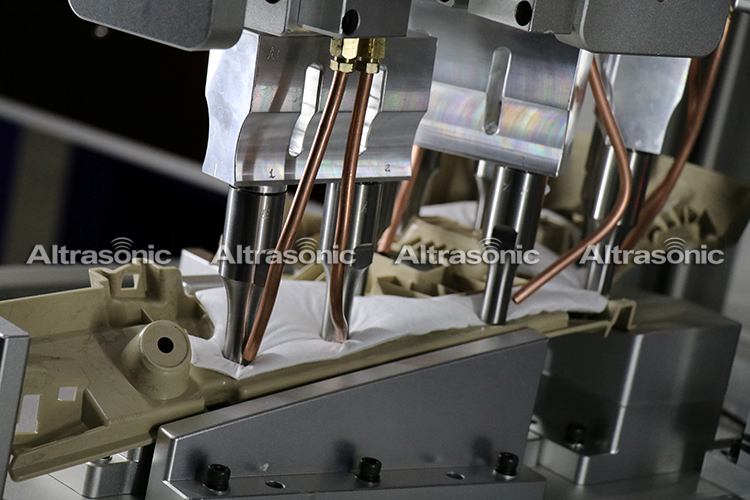
Application of ultrasonic plastic welding in the automotive industry
In
modern vehicles, whether it is exterior decorative parts (such as bumpers,
fenders, wheel covers, deflectors, etc.), interior decorative parts (such as
instrument panels, door inner panels, sub-dashboards, glove compartment covers,
seats) Chairs, rear guards, etc.), or functional and structural parts (fuel
tank, radiator water chamber, air filter cover, fan blades, etc.), the shadow
of plastic parts can be seen everywhere.At present, 100kg plastic materials on
modern cars replace the traditional metal materials that originally required
200-300kg, and the weight-reduction effect is very prominent, which is of great
significance for saving energy and reducing greenhouse gas emissions. For
example, the replacement of metal by automobile plastic intake manifold can
reduce the quality by 40% to 60%, and the surface light clear flow resistance
is small, which can improve engine performance and play a certain role in
improving combustion efficiency, reducing fuel consumption, vibration and noise
reduction.According to statistics, there are dozens of plastics for
automobiles, and the average amount of plastics per vehicle has accounted for
5% to 10% of the weight of automobiles. With the development of lightweight
vehicles and the expansion of automotive plastics, automotive plastics The
consumption of bicycles will further increase in the future.
There
are two types of plastics for automobiles: one is a thermosetting plastic that
can withstand ordinary baking operations; the other is a thermoplastic, which
has the advantage of being easy and fast to process. Among the plastics for
vehicles, the top 7 plastic materials and their proportions are roughly: 21%
for polypropylene, 19.6% for polyurethane, 12.2% for polyvinyl chloride, 10.4%
for thermoset composites, and ABS 8 %, nylon 7.8%, polyethylene 6%.
For
example, the automobile bumper welding machine adopts a plate-type structure
(reference material), and the heat of the heating plate is transferred to the
welding surface of the upper and lower plastic heating members by an electric
heating method. The surface is melted, and then the heating plate is quickly
withdrawn. After heating the upper and lower heating members, the molten
surface is fused, solidified and integrated. The whole machine is in the form
of frame. It consists of three plates: upper template, lower template and hot
template. It is equipped with hot mold, upper and lower plastic cold mold, and
the action mode is pneumatic control. It is mainly used for welding of plastic
parts such as household appliances, car lights and car dissolvers.The heating
power and the die size can be set according to different plastic parts to
realize welding of various plastic workpieces, and the operation is simple and
convenient to use. The heating plate consists of two upper and lower blocks and
is heated by an electric heating tube. There are two temperature controllers in
the machine to control the temperature of the upper and lower molds. When
welding, it can be set within the range of 0 to 600 °C according to the actual
needs of welding. The control mode of the device can be divided into manual and
automatic control. The manual is a single-piece action, which is mainly used
for debugging of the mechanism and the mold. After manual debugging, the
production is adjusted to automatic. The automatic control system is controlled
by a programmable controller (PLC) and a touch screen human machine interface.

The
car bumper welding machine uses the principle of electrothermal melting to
prepare for controlling temperature changes, and is equipped with perfect
mechanical devices to achieve perfect welding, which makes up for the shortage
of ultrasonic welding machines for welding large and special plastic parts. It
is mainly used for welding of thermoplastic materials such as PP and PE and
plastic workpieces with large and complicated weld area.
Plastic
connections are a key part of their widespread use. The plastic can be joined
by mechanical fastening, bonding or welding. The fast fastening connection is
suitable for all plastics, but it is costly, stress-concentrated, does not form
a sealed joint or achieves proper performance. Bonding provides excellent
performance and high quality joints, but it is difficult to operate, requires
careful joint and surface preparation, and is very slow and not suitable for
mass production. The welding is economical, simple, fast and reliable, and can
form joints with static strength close to that of the base metal, so it is
suitable for mass production and has been increasingly used in the automotive
industry. The level of plastic welding technology has become one of the
indicators to measure the level of automotive production technology and the
level of new material development.
© Copyright: 2025 Hangzhou Altrasonic Technology Co.,Ltd All Rights Reserved

IPv6 network supported
Scan to WhatsApp
